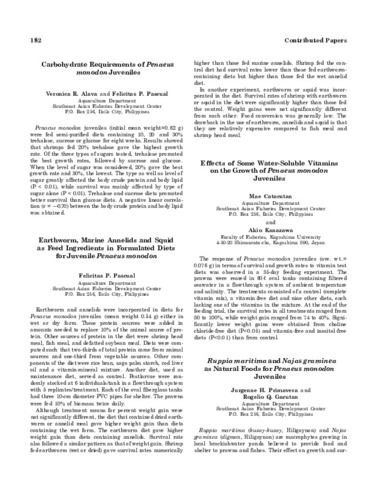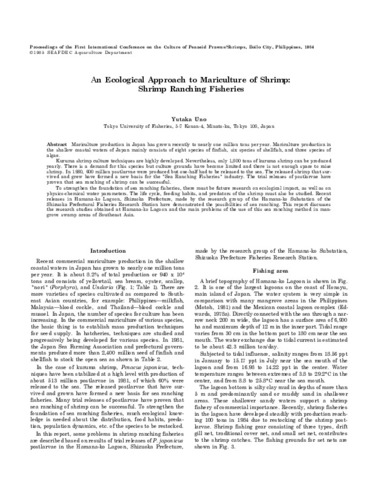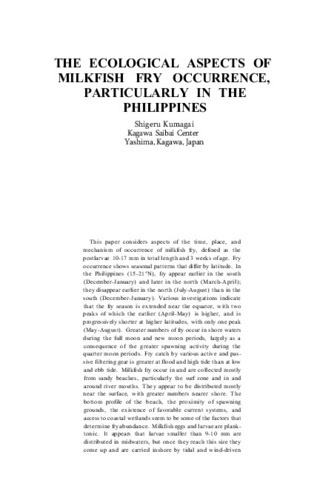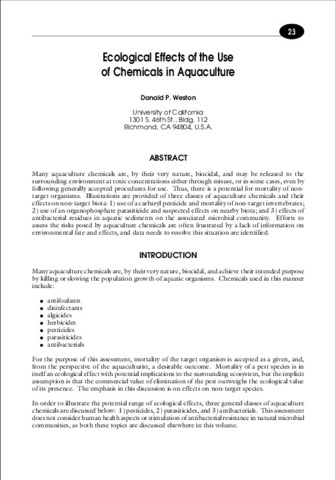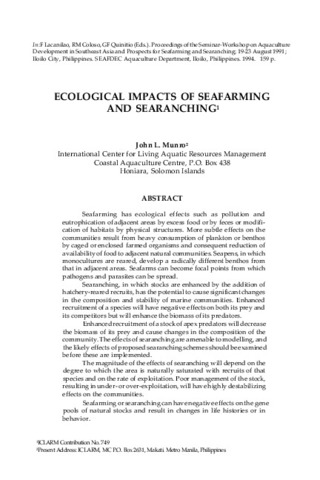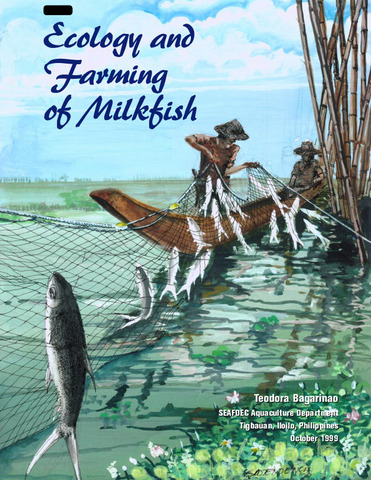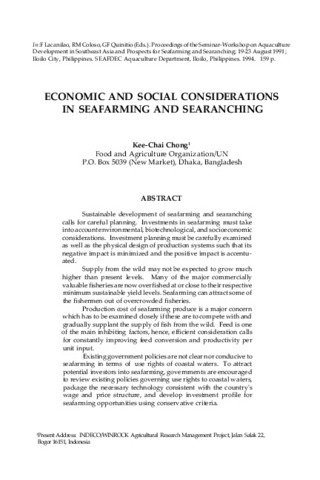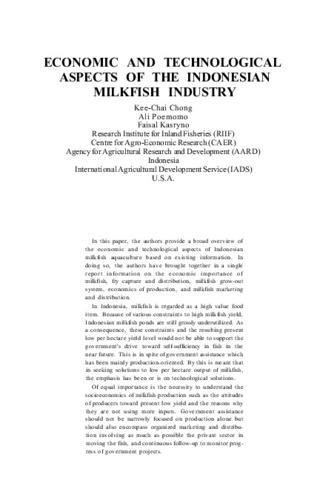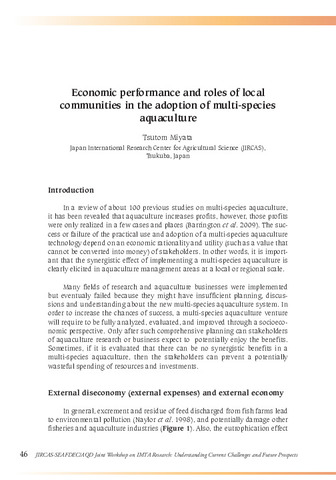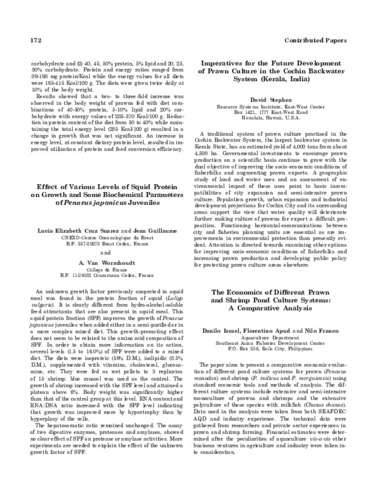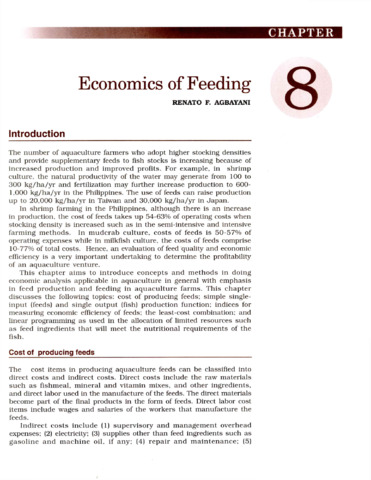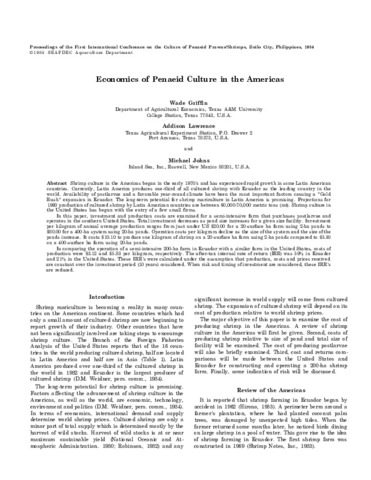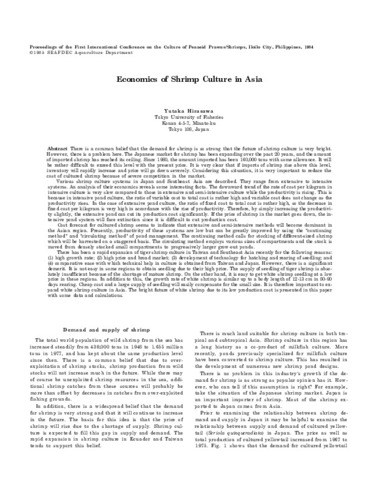Browsing 01 SEAFDEC/AQD Publications by Title
Now showing items 666-685 of 2111
-
Earthworm, marine annelids and squid as feed ingredients in formulated diets for juvenile Penaeus monodon
(Aquaculture Department, Southeast Asian Fisheries Development Center, 1985)Earthworm and annelids were incorporated in diets for Penaeus monodon juveniles (mean weight 0.54 g) either in wet or dry form. These protein sources were added in amounts needed to replace 10% of the animal source of ... -
An ecological approach to mariculture of shrimp: Shrimp ranching fisheries
(Aquaculture Department, Southeast Asian Fisheries Development Center, 1985)Mariculture production in Japan has grown recently to nearly one million tons per year. Mariculture production in the shallow coastal waters of Japan mainly consists of eight species of finfish, six species of shellfish, ... -
The ecological aspects of milkfish fry occurrence, particularly in the Philippines
(Aquaculture Department, Southeast Asian Fisheries Development Center; International Development Research Centre; Island Publishing House, Inc., 1984)Aspects of the time, place, and mechanism of occurrence of milkfish (Chanos chanos ) fry, defined as the postlarvae 10-17 mm in total length and 3 weeks of age are considered. Fry occurrence shows seasonal patterns that ... -
An ecological assessment of seven major lakes in the Philippines
(Aquaculture Department, Southeast Asian Fisheries Development Center; Philippine Council for Aquatic and Marine Research and Development (PCAMRD), Department of Science and Technology; Bureau of Fisheries and Aquatic Resources, 2001)An ecological assessment was done on the seven major lakes in the Philippines, namely; Laguna de Bay, Taal, Naujan, Lanao, Mainit, Buluan, and Bato. The assessment was based largely on secondary data and some primary data. ... -
Ecological effects of the use of chemicals in aquaculture
(Aquaculture Department, Southeast Asian Fisheries Development Center, 2000)Many aquaculture chemicals are, by their very nature, biocidal, and may be released to the surrounding environment at toxic concentrations either through misuse, or in some cases, even by following generally accepted ... -
Ecological impacts of coastal aquaculture developments
(Aquaculture Department, Southeast Asian Fisheries Development Center, 1995)The study presents the type and scale of any ecological change associated with coastal aquaculture development. These are enrichment, interaction with the food web, oxygen consumption, disturbance of wildlife and habitat ... -
Ecological impacts of seafarming and searanching
(Aquaculture Department, Southeast Asian Fisheries Development Center, 1994)Seafarming has ecological effects such as pollution and eutrophication of adjacent areas by excess food or by feces or modification of habitats by physical structures. More subtle effects on the communities result from ... -
Ecological limits of high-density milkfish farming
(Aquaculture Department, Southeast Asian Fisheries Development Center, 1997)In the Philippines at present, milkfish farming in ponds includes a wide range of intensities, systems and practices. To make aquaculture possible, ecosystems are used as sources of energy and resources and as sinks for ... -
Ecology and farming of milkfish
(Aquaculture Department, Southeast Asian Fisheries Development Center, 1999)This book is a reader-friendly illustrated account of the life history of milkfish (Chanos chanos) in nature and in aquaculture. It describes the different farming systems and status of the milkfish industry, and recommends ... -
Ecology and life history of penaeid shrimps
(Aquaculture Department, Southeast Asian Fisheries Development Center, 1977)Fourteen species of penaeid shrimps with commercial value in Batan Bay and Tigbauan-Guimbal waters were identified as follows: Penaeus monodon, P. semisulcatus, P. japonicus, Metapenaeus ensis, M. burkenroadi, M. endeavouri, ... -
Economic analysis of an integrated milkfish broodstock and hatchery operation
(Aquaculture Department, Southeast Asian Fisheries Development Center, 1993) -
Economic and social considerations in seafarming and searanching
(Aquaculture Department, Southeast Asian Fisheries Development Center, 1994)Sustainable development of seafarming and searanching calls for careful planning. Investments in seafarming must take into account environmental, biotechnological, and socioeconomic considerations. Investment planning must ... -
Economic and technological aspects of the Indonesian milkfish industry
(Aquaculture Department, Southeast Asian Fisheries Development Center; International Development Research Centre; Island Publishing House, Inc., 1984)A broad overview is presented of the economic and technological aspects of Indonesian milkfish (Chanos chanos ) aquaculture covering information on the economic importance of milkfish, fry capture and distribution, milkfish ... -
Economic performance and roles of local communities in the adoption of multi-species aquaculture
(Aquaculture Department, Southeast Asian Fisheries Development Center; Japan International Research Center for Agricultural Sciences, 2022-07) -
Economic value of the milkfish industry
(Aquaculture Department, Southeast Asian Fisheries Development Center, 1998)A brief description is given of the milkfish (Chanos chanos) farming industry in the Philippines. Over the past 20 years, the relative importance of milkfish has declined with the expansion of tilapia, tiger shrimp and ... -
The economics of different prawn and shrimp pond culture systems: A comparative analysis
(Aquaculture Department, Southeast Asian Fisheries Development Center, 1985)The paper aims to present a comparative economic evaluation of different pond culture systems for prawn (Penaeus monodon) and shrimp (P. indicus and P. merguiensis) using standard economic tools and methods of analysis. ... -
Economics of feeding
(Aquaculture Department, Southeast Asian Fisheries Development Center, 2002)This chapter aims to introduce concepts and methods in doing economic analysis applicable in aquaculture in general with emphasis in feed production and feeding in aquaculture farms. This chapter discusses the following ... -
The economics of mudcrab monoculture
(Aquaculture Department, Southeast Asian Fisheries Development Center, 1992) -
Economics of penaeid culture in the Americas
(Aquaculture Department, Southeast Asian Fisheries Development Center, 1985)Shrimp culture in the Americas began in the early 1970's and has experienced rapid growth in some Latin American countries. Currently, Latin America produces one-third of all cultured shrimp with Ecuador as the leading ... -
Economics of shrimp culture in Asia
(Aquaculture Department, Southeast Asian Fisheries Development Center, 1985)There is a common belief that the demand for shrimp is so strong that the future of shrimp culture is very bright. However, there is a problem here. The Japanese market for shrimp has been expanding over the past 20 years, ...

